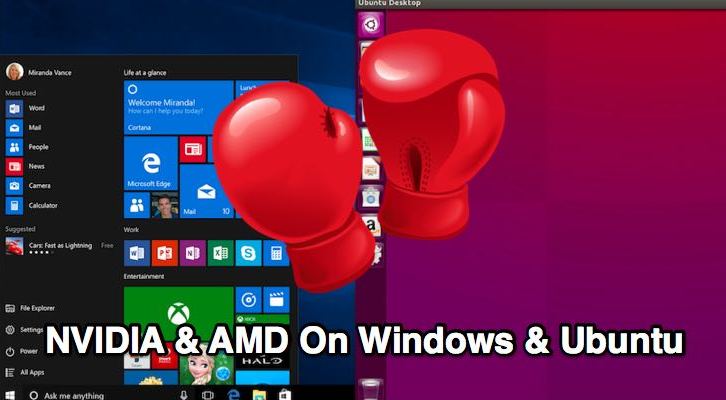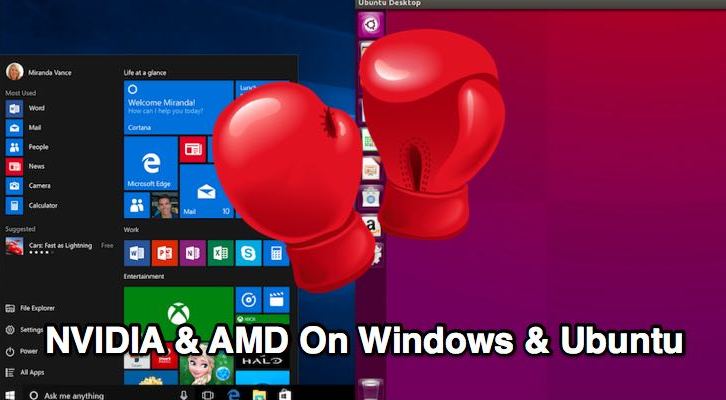 Short Bytes: With the release of polished Ubuntu 16.04 LTS, it’s time to compare the performance of different graphics cards and drivers on Windows 10 and Ubuntu LTS. The benchmark tests of NVIDIA and AMD graphics cards show that the graphics performance on Linux machine gives a tough competition to Windows 10.
Short Bytes: With the release of polished Ubuntu 16.04 LTS, it’s time to compare the performance of different graphics cards and drivers on Windows 10 and Ubuntu LTS. The benchmark tests of NVIDIA and AMD graphics cards show that the graphics performance on Linux machine gives a tough competition to Windows 10.
Millions of people have already upgraded to Microsoft’s operating system Windows 10. If we talk about Windows 10’s biggest open source competitors, the first name that pops in our mind is of Ubuntu Linux.
With Ubuntu 16.04’s release (download and upgrade here), I thought it’s a good opportunity to share the results of a number of OpneGL benchmarks on both Windows 10 and Ubuntu 16.04 Linux with the same set of graphics card and other hardware specifications.
Here I’ll be sharing the results of the comprehensive tests conducted by Phoronix, a leading Linux hardware review website.
Let’s take a look at graphics performance of Ubuntu 16.04 LTS and Windows 10 on NVIDIA and AMD graphics one by one:
Ubuntu 16.04 LTS vs. Windows 10 — NVIDIA OpenGL
Operating systems used for testing:
This test to compare the NVIDIA graphics performance on Ubuntu 16.04 and Windows 10 used the latest Windows 10 Insider Build 14316 and an Ubuntu 16.04 development snapshot.
Hardware used for testing:
The system that was used for testing comprised of Intel Xeon E3-1280 v5 CPU, MSI C236A Workstation motherboard, 120GB Samsung SSD 850 EVO SSD, 16GB RAM. The different NVIDIA GPUs that were used represented both high-end and low-end GPUs — GeForce GTX 950, GTX 970, GTX 980 Ti, and GTX TITAN X.
NVIDIA driver used for testing:
To perform the test on Ubuntu, NVIDIA 364.15 driver release was used while the NVIDIA 364.72 driver release was used for Windows 10.
Ubuntu 16.04 LTS vs. Windows 10 results for NVIDIA:
If we look at the results, they aren’t too different from the ones we have seen in the past. While using NVIDIA’s official drivers, the performance was very close between Windows and Linux. On higher end graphics cards, Ubuntu with NVIDIA driver in the CPU bound scenarios came out ahead.
Here are the main points of the result:
- With the basic CPU limited OpenArea test, Ubuntu 16.04 performed faster than Windows 10.
- In heavier Unigine tests, the Windows 10 and Ubuntu 16.04 performance came very close. Still, Ubuntu 16.04 managed to steal few more frames than Windows 10.
- In basic test case with Xonotic, Ubuntu 16.04 performed better. Ramping up the image quality settings, Windows 10 performed better.
- The tests on GpuTest scored few more wins for Ubuntu 16.04 on NVIDIA 364.15.
Read more on Phoronix
Ubuntu 16.04 LTS vs. Windows 10 — Radeon AMDGPU
Operating systems used for testing:
This test to compare the NVIDIA graphics performance on Ubuntu 16.04 and Windows 10 used the latest Windows 10 Pro x64 and an Ubuntu 16.04 x86_64 with the Linux 4.4.
Hardware used for testing:
The system that was used for testing comprised of Intel Xeon E3-1280 v5 CPU, MSI C236A Workstation motherboard, 120GB Samsung SSD 850 EVO SSD, 16GB RAM. The different NVIDIA GPUs that were used represented both two Radeon GPUs — Radeon R9 285 (Tonga) and Radeon R9 Fury (Fiji)
Drivers used for testing:
To perform the test the drivers used were — Radeon Software Crimson Edition on Windows 10, AMDGPU on Ubuntu 16.04, and the new AMDGPU PRO driver stack on Ubuntu 16.04.
Ubuntu 16.04 LTS vs. Windows 10 results for AMD and Radeon:
The Ubuntu 16.04 vs. Windows 10 results indicate that AMDGPU PRO driver stack competed very well with Windows 10’s Radeon Software driver. The open source driver stack with RadeonSI Gallium3D was competitive with closed source driver in OpenGL test. The big surprise came in the form of Unigine Heaven and Xonotic tests at heavier settings.
Here are the main points of the result:
- In the basic and classic test OpenArena, Linux driver performance exceeded Windows 10 with Radeon Software Crimson. The hybrid PRO and open source drives performed similarly.
- In Unigine Heaven, the performance on Ubuntu 16.04 and Windows 10 was similar. Compared to AMD closed source drivers, the open source stack with Mesa 11.2 was slower.
- In Unigine Valley, AMDGPU PRO on Linux and Windows driver did much better, This time, open source driver was more competitive.
- Xonotic with low settings resulted in open source Ubuntu out-of-the-box driver beating other drivers. But, as settings were made heavier, open source driver fell behind OpenGL drivers.
- In basic tests, open source Linux driver with Radeon R9 285 and R9 Fury was very competitive with Windows 10’s Radeon and PRO driver on Linux.
Read more on Phoronix.
Did you find this article interesting? Share your views in the comments below.
Also read: Best Ubuntu 16.04 Features — Download And Upgrade To Xenial Xerus Now










